Classic Crispy & Tender Pork Chop Milanese Recipe: An Italian Family Favorite
Discover the secret to making the crispiest, most tender, and flavorful pork cutlets in under 30 minutes with this authentic Classic Pork Chop Milanese recipe. This iconic Italian dish transforms simple pork chops into a golden-brown culinary delight, perfect for serving over a fresh, light green salad or alongside your favorite Italian sides. Forget dry, tough pork chops – this method guarantees a juicy interior and an irresistibly crunchy crust every single time.

If you’re craving more delightful crispy Italian-style dishes that capture the essence of homemade comfort, be sure to explore our Easy Italian Fried Green Tomatoes for a vibrant appetizer or our Fried Flounder Oreganata for another fantastic seafood option. These recipes, much like our Milanese, celebrate simple ingredients and robust flavors that truly shine.
[feast_advanced_jump_to]
Why You’ll Love This Crispy Pork Chop Milanese Recipe
Let me be honest with you. Growing up, pork chops were never a favorite in our Italian household. My dad and I shared a mutual dislike for them. It often felt like they were only served to break the routine of having delicious Italian Chicken Cutlets every week. We certainly never had this classic Pork Chop Milanese when I was a kid; instead, our pork chops were usually coated in “Shake ‘n Bake.” I can still remember my brothers and I picking off the coating and declaring, “we’re done!” – leaving the actual pork untouched.
This recipe, however, is a game-changer for all the former pork chop haters out there. A few years ago, my dad started preparing pork chops this way, and we haven’t looked back since. These Milanese-style pork chops are incredibly tender and moist on the inside, encased in an extra-crispy, golden crust. They perfectly balance a rich flavor with a satisfying texture that will convert even the most skeptical eaters.
The beauty of Pork Chop Milanese lies in its versatility. In the colder months, they pair wonderfully with warm and savory Garlic Parmesan Green Beans. When summer rolls around, they’re equally delightful with a refreshing, chilled Italian Green Bean Salad. This dish effortlessly adapts to any season, making it a reliable staple for family dinners or entertaining guests.
A crucial step to achieving this unparalleled tenderness is proper meat tenderization. My dad, a true culinary enthusiast, even goes as far as asking the butcher to run the pork chops through the tenderizer multiple times to get them as thin as possible. The thinner and more tenderized the chops, the more moist and delicious they become. This technique is similar to how we achieve the perfect thin and tender consistency for our Authentic Italian Braciole. By breaking down the muscle fibers, you ensure a quicker cooking time and a wonderfully succulent result that melts in your mouth.
Essential Ingredients & Smart Substitutions for Milanese
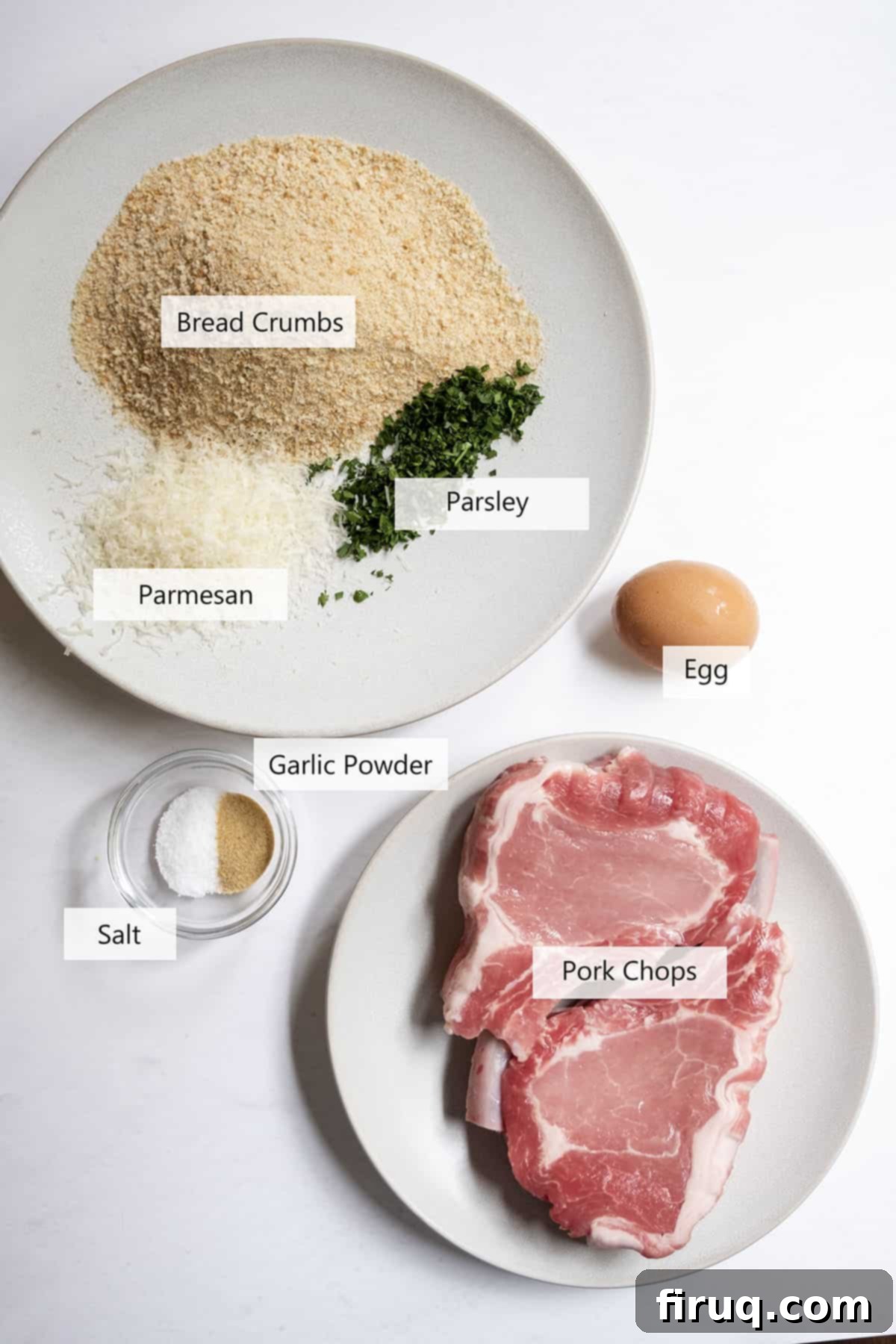
- Bone-in Pork Chops: For the ultimate juicy and tender results, bone-in pork chops are always preferred. The bone helps to insulate the meat, locking in moisture and adding a depth of flavor that boneless chops often lack. They also tend to be a more generous portion, making for a satisfying meal. While you can substitute boneless pork chops, keep in mind they are typically thinner and will cook much faster. Always adjust your cooking time accordingly and rely on an internal thermometer to ensure they reach the perfect doneness (145°F). For more tips on achieving ideal tenderness with boneless cuts, check out our guide on making PERFECT Cast Iron Boneless Pork Chops.
- Breadcrumbs Mixture: This recipe utilizes a classic Italian breadcrumbs mixture, providing that signature crispy golden crust. You can use plain breadcrumbs as a base and add your own seasonings, or opt for pre-seasoned Italian breadcrumbs for convenience. For an even crispier texture, consider using Panko breadcrumbs, which are lighter and flakier. Feel free to customize the blend with additional dried herbs like oregano or basil for an enhanced aromatic profile.
- Extra Virgin Olive Oil: We pan-fry these pork chops in high-quality extra virgin olive oil. The moderate heat required for frying Milanese allows the olive oil to impart a wonderful, subtle flavor without reaching its smoke point. It’s crucial to maintain a medium heat; if your oil starts smoking, it’s too hot and will burn the breadcrumbs before the pork is cooked through. Reduce the heat immediately or replace the oil if it has overheated.
- Egg: The egg acts as a crucial binding agent, helping the breadcrumbs adhere firmly to the pork chops, creating that essential crispy coating. If you’re looking for alternatives due to dietary restrictions or preferences, several respectable substitutes exist. Heavy cream or buttermilk can offer a similar binding effect and richness. For a vegan option, a flax egg (ground flaxseed mixed with water) or aquafaba (chickpea brine) can also work. For a detailed analysis of various egg substitutes and their impact on fried cutlets, see our recipe for No Egg Chicken Cutlets.
- Freshly Grated Parmesan: Using freshly grated Parmigiano-Reggiano elevates the flavor profile, adding a salty, umami depth to the breading. Avoid pre-grated parmesan, which often contains anti-caking agents that can hinder the crispiness.
- Fresh Parsley, Salt, and Garlic Powder: These seasonings are fundamental to the Italian breadcrumb blend. Fresh parsley adds a vibrant, herbaceous note, while garlic powder provides a savory punch. Adjust salt and pepper to your taste, ensuring adequate seasoning for both the pork and the breading.
*Please refer to the complete recipe card below for precise measurements and detailed instructions.
Mastering the Art of Pork Chop Milanese: Step-by-Step Guide
The key to exceptionally tender pork chop cutlets lies in meticulous preparation. Properly tenderizing and seasoning the pork chops are the most vital steps to ensure they are flavorful, moist, and cook evenly without becoming tough.
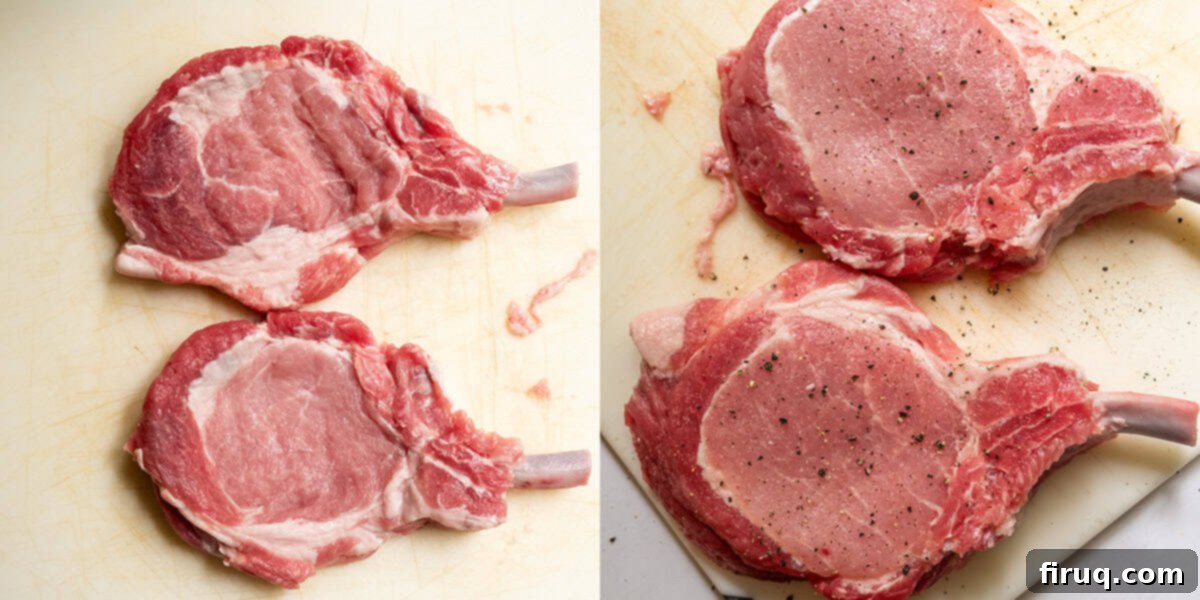
Step 1: Tenderize and Season the Pork. Place each pork chop between two sheets of plastic wrap. Using a meat tenderizer (or the flat side of a heavy pan), firmly beat the pork chop until it is approximately half its original thickness. Aim for an even thickness across the entire chop for consistent cooking. This process breaks down tough muscle fibers, ensuring a tender bite. Once tenderized, generously season both sides of the pork chop with salt and freshly ground black pepper.
Step 2: Prepare the Breading Station. On a shallow plate, combine your breadcrumbs, freshly grated Parmesan cheese, chopped fresh parsley, salt, and garlic powder. Mix these ingredients thoroughly to ensure an even distribution of flavor. In a separate shallow bowl, whisk the egg until the yolk and white are fully combined and slightly frothy. Setting up a “dredging station” like this makes the breading process smooth and efficient.

Step 3: Egg Wash. Carefully dip each tenderized pork chop into the whisked egg, ensuring both sides are fully coated. Allow any excess egg to drip off before moving to the next step. This thin layer of egg will help the breadcrumbs adhere.
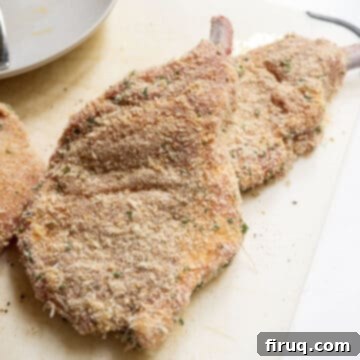
Step 4: Breading the Pork. Transfer the egg-washed pork chop to the plate with the breadcrumb mixture. Generously coat both sides, pressing the breadcrumbs firmly into the meat with your hand. This crucial step ensures the breading forms a secure, crispy crust that won’t fall off during frying.
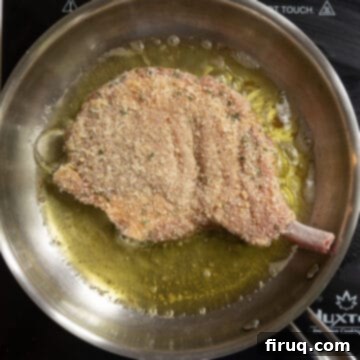
Step 5: Pan-Frying for Golden Perfection. Heat about ¼ cup of extra virgin olive oil in a large saucepan or cast-iron skillet over medium heat. You’ll know the oil is ready when it starts to shimmer gently and a small breadcrumb dropped in sizzles immediately. Carefully place your breaded pork chops into the hot oil in batches, ensuring not to overcrowd the pan. Overcrowding lowers the oil temperature, leading to soggy, rather than crispy, cutlets. Fry each side for 3-6 minutes, or until deeply golden brown and cooked through. Cooking time will vary based on the thickness of your pork chops.
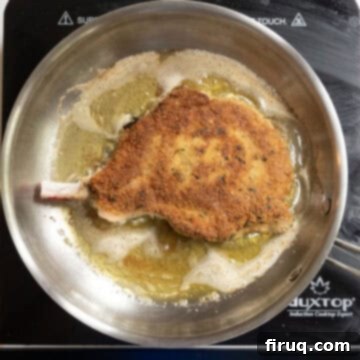
Step 6: Achieve Doneness and Rest. Each side of the pork chop should be a beautiful golden brown color, indicating a perfect crisp. Remove the pork chops from the pan when their internal temperature reaches 145 degrees F for optimal juiciness. Transfer them to a wire cooling rack set over a baking sheet to rest for a few minutes. This resting period allows the juices to redistribute throughout the meat, resulting in an even more tender and moist cutlet, while the rack helps maintain the crispy coating.
Serve your exquisite Pork Chop Milanese immediately over a small, crisp green salad, lightly dressed with a squeeze of fresh lemon and a drizzle of extra virgin olive oil. For a more adventurous flavor, consider a homemade Lemon Basil Vinaigrette. Beyond salads, these cutlets are wonderful with hearty sides like Crispy Garlic Parmesan Potatoes or classic pasta dishes such as Pasta Alla Gricia or a light and fresh Italian Summer Pasta with Zucchini.
If you happen to have any delicious leftovers, they can be repurposed into new and exciting meals! Try adding slices of the leftover pork chops to our rich Creamy Lemon Sauce for a quick weeknight dinner, or experiment with unexpected flavors like our Bourbon Peach Glazed Pork Chops, which offers a delightful sweet and savory contrast.
Pro-Tips for the Perfect Pork Chop Milanese
- Tenderize Your Meat Liberally: This step is absolutely non-negotiable for tender pork chops. If you skip this, your chops will likely turn out tough and dry, requiring longer cooking times and increasing the risk of burning the breading. Don’t own a meat tenderizer? No problem! A heavy object like a can of beans wrapped in a clean kitchen towel or plastic wrap works just as effectively. Beat the pork chops until they are significantly thinner, about 1/2 to 3/4 inch thick. This breaks down muscle fibers, ensuring a super tender and quick-cooking result.
- Pat Your Breadcrumbs Firmly: After dredging the pork chops in the breadcrumb mixture, use the palm of your hand to firmly pat the breadcrumbs onto both sides of the meat. This creates a secure, even coating that is less likely to detach during frying, guaranteeing that beautiful, crispy crust.
- Prepare in Advance for Extra Crispiness: For an even crispier Milanese, consider breading your pork chops the night before. Arrange them on a wire rack set over a baking sheet and refrigerate uncovered. This allows the breading to dry out slightly, or “dehumidify,” which results in a significantly crispier fry in the olive oil the next day, as there’s less moisture to evaporate during cooking.
- Mind the Oil Temperature (Especially for Bone-in Chops): Bone-in pork chops generally take longer to cook through than boneless ones due to the bone’s insulation. For this reason, it’s crucial to fry them at a consistent medium heat. If your olive oil starts smoking, it’s too hot, especially for bone-in chops. High heat will quickly burn the exterior breading while leaving the interior undercooked. If you see smoke, immediately reduce the temperature and consider starting with fresh olive oil if the current oil has become acrid. Boneless chops, being thinner, can tolerate a slightly higher temperature, but always prioritize a golden-brown crust and a cooked interior.
- Don’t Overcrowd the Pan: Frying too many pork chops at once will drastically lower the oil’s temperature. This leads to steaming rather than frying, resulting in a soggy crust and uneven cooking. Work in batches to ensure each chop gets ample space and maintains consistent oil temperature for optimal crispiness.
- Rest Your Meat: After frying, transfer the cooked pork chops to a wire rack. Allowing them to rest for 5-10 minutes helps the internal juices redistribute throughout the meat. This simple step ensures maximum juiciness and tenderness when you slice into them.

Pork Chop Milanese FAQs
The most common reason for tough pork chops is inadequate tenderization. If you don’t use a meat tenderizer (or a heavy object to pound them thin), the muscle fibers remain intact, resulting in a chewy and dry texture. Additionally, overcooking can make them tough. Always cook pork chops to an internal temperature of 145°F, followed by a brief rest.
For Pork Chop Milanese, I highly recommend a crisp, dry white wine like a Sauvignon Blanc or a Pinot Grigio. Their bright acidity and subtle fruit notes beautifully cut through the richness of the fried pork, creating a balanced and refreshing pairing. A light-bodied Chardonnay (unoaked) would also be a great choice.
Beyond proper tenderization and not overcooking, dry brining is an excellent technique for incredibly moist pork chops. Season your pork chops generously with salt on a wire rack in the refrigerator overnight. The salt draws moisture out, then reabsorbs it, leading to a more flavorful and juicy chop. Always tenderize them after brining and cook as usual.
While pan-frying offers the most authentic Milanese experience with a truly crispy crust, you can achieve good results in an air fryer or oven. For an air fryer, spray the breaded chops with cooking spray and cook at 375°F (190°C) for 10-15 minutes, flipping halfway, until golden and cooked through. For oven baking, bake at 400°F (200°C) for 15-20 minutes, flipping once, until golden and crispy. Both methods might require a bit more oil spray to achieve that desired golden color and crunch.
Store leftover pork chops in an airtight container in the refrigerator for up to 3-4 days. To reheat and maintain crispiness, avoid the microwave. Instead, reheat in a preheated oven at 350°F (175°C) for 10-15 minutes, or in an air fryer at 325°F (160°C) for 5-8 minutes, until heated through and the breading has crisped up again.
More Classic Italian Recipes to Enjoy
- Restaurant-Style Chicken Marsala
- The BEST Chicken Pizzaiola
- Restaurant-Style Chicken Francese
- Easy Chicken Cacciatore
Please leave a comment and star rating below in the recipe card! I love to hear what you think of our recipes and your culinary adventures. Feel free to tag us on Instagram @vindelgiudice to share your delicious creations!
📖 Recipe
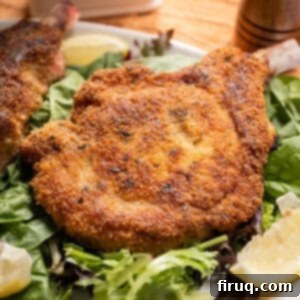
Classic Pork Chop Milanese
Vincent DelGiudice
Pin Recipe
Equipment
-
1 Saucepan
-
1 plate for dredging
-
1 Small bowl
Ingredients
- 4 bone-in or boneless pork chops
- 1 egg
- 1 cup breadcrumbs
- ¼ cup Parmesan
- 2 tablespoon fresh parsley
- 1 teaspoon salt
- 1 tablespoon garlic powder
- ¼ cup extra virgin olive oil
- salt and pepper
- 6 oz Spring mix
- ½ lemon
Instructions
-
In a shallow plate, combine the breadcrumbs, Parmesan cheese, fresh parsley, salt, and garlic powder. Mix well. In a separate shallow bowl, whisk the egg until smooth.
-
Place each pork chop between two pieces of plastic wrap and use a meat tenderizer to pound them until they are about half their original thickness. Season both sides with salt and pepper. Dip each pork chop thoroughly into the whisked egg, then dredge it completely in the breadcrumb mixture, pressing firmly to ensure the coating adheres well.
-
Heat ¼ cup of extra virgin olive oil in a large saucepan over medium heat until shimmering. Place the breaded pork chops in the oil in batches, being careful not to overcrowd the pan. Fry each side for 3-6 minutes, or until deeply golden brown and cooked through. The cooking time will vary based on the thickness of the pork chop. Remove the pork chops from the pan when their internal temperature reaches 145℉ and let them rest on a wire cooling rack.
-
Serve your Pork Chop Milanese immediately over a small bed of spring mix, drizzled with olive oil and a fresh squeeze of lemon juice.
Notes
- Bone-in pork chops will take longer to fry than boneless pork chops. Boneless can be cooked at a slightly higher temperature. If your olive oil is smoking, it is too hot for the bone-in pork chops and you’ll end up burning the outside and not cooking the inside. Lower the temperature or start with fresh olive oil.
- Dredging the pork chops in breadcrumbs can be done in advance and stored in the refrigerator. Storing them in the refrigerator will actually dehumidify them and let them get a crispier and better fry because there will be less moisture overall.
- Tenderize your meat. Do not think you can skip this step. If you don’t have a meat tenderizer, you can use a can of beans. Just beat the heck out of the pork chops otherwise they will take longer to cook through, be easier to burn, and turn out tough.
- Pat your bread crumbs into the pork chop. This will help to make sure the bread crumbs stay on the pork chop while you’re frying them.
Nutrition
Tried this recipe?We’d love for you to Leave a Review!
